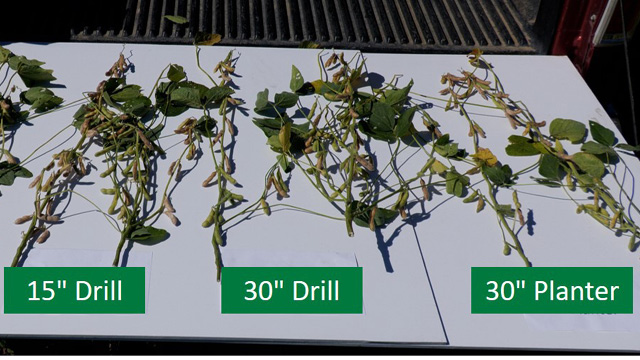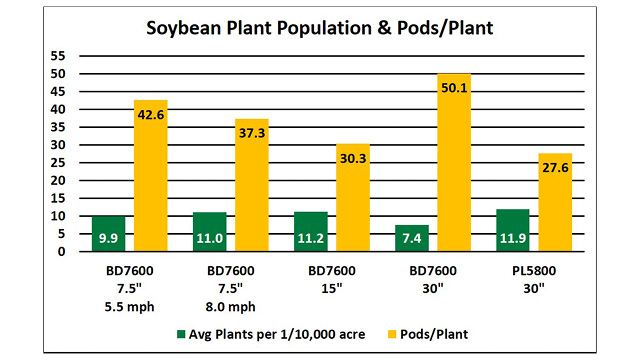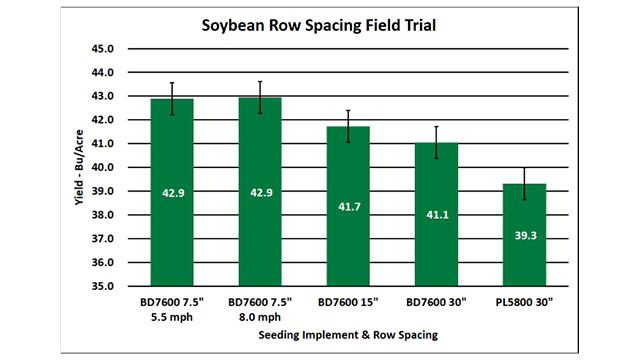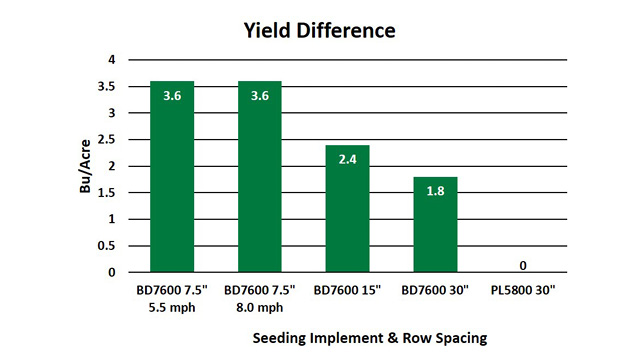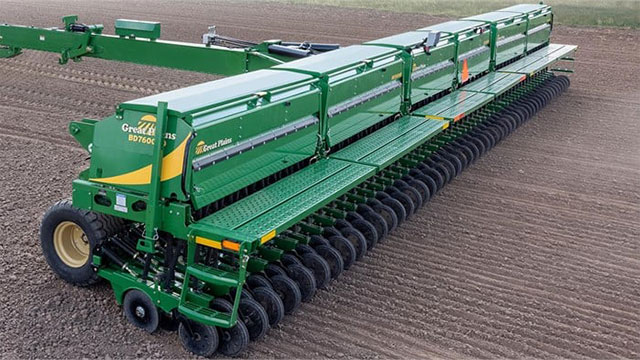Rethink The Value Of Drilling Soybeans
Is it better to plant soybeans with a 30"-row planter or a drill? This was the question Great Plains set out to answer through a 2021 on-farm field trial. While it is true that traditional drills have the reputation for being less precise than a planter, Great Plains’ newest drill model, the BD7600, offers several enhancements that improve seeding accuracy and placement compared to other grain drills available in the marketplace.
Field Trial Design:
The field trial was conducted in Saline County in central Kansas, using a Great Plains BD7600 set on 7.5", 15", and 30" row spacing and a Great Plains PL5800 set on 30" row spacing. Prior to running, both pieces of equipment were calibrated with a target population of 120,000 seeds per acre.
In addition to the row-spacing field trial, planting speeds were also evaluated to explore the effects of planting on seeding accuracy and final yield. For the BD7600, 7.5" rows were planted at 5.5 mph and 8.0 mph, while the 15" and 30" rows were planted at 5.5 mph. The planted 30" treatment was performed using a typical planting speed of 7.0 mph.
Each of the five treatments were replicated three times within this field trial, and each treatment section measured 40-ft wide and 1,890-ft in length. The target seeding rate was 120,000 seeds per acre, or 41.5 lbs. per acre based upon 2,890 seeds/lb.
Before the soybean crop, grain sorghum was grown the previous year. The soybeans were seeded into a tilled seedbed that had been disked and cultivated earlier in the spring. The field was planted on May 7, 2021, and harvested on October 15, 2021.
Field Trial Results:
Throughout this field trial, several data points were collected to give insight into the yield components of the drilled and planted soybeans.
Stand Counts
For early season stand counts, the plant population for the 7.5" and 15" drilled soybeans was 85%-94% of the targeted seeding rate. While the drill did not achieve as high of plant population as the planter, it was still within the targeted soybean population range to optimize yield potential.
The planter performed exceptionally well in terms of plant emergence. It produced a stand that was within 2% of the targeted seed population.
The 30" drilled soybeans showed a much lower stand population: 70% of the target population. While this plant population is slightly lower than the typical target to maximize yields, it still produced an adequate stand that did not warrant replanting.
Prior to harvest, stand counts were taken as a component for estimating yield potential later in the growing season. All treatments showed stand counts either remained similar, or fell slightly, when compared to the early season stand counts.
Pods per Plant and Pods per Acre
Pods per plant varied between treatments based upon row spacing and plant population. The 30" drilled soybeans showed the highest pods per plant. This treatment, however, also had the lowest plant population. Because of the lower population, it is possible these plants compensated by adding more pods.
To achieve maximum yield potential, the correct balance of plants per acre and pods per plant must be met. When considering the pods per acre, the 7.5" row spacing showed the highest amount, with approximately 21% more pods per acre compared to the 30" planted soybeans.
Pod Weight per Plant
Pod weight per plant was similar for all treatments, with the exception of the 30" planted beans that had nearly a 7% lower pod weight. While seeds per pod were not documented, it is our speculation that on average, the 30" soybeans resulted in fewer seeds per pod compared to the other row spacings.
Grain Yields
Yield differences were noted among row spacing treatments. The 7.5" row spacing exhibited the highest yield of all treatments and resulted in a 3.6 bu. per acre—or approximately an 8%— yield advantage over the soybeans planted on 30" spacing. From an economic standpoint, at $12 per bu. soybean price, this equates to a $43/acre advantage for the narrow-row 7.5" drilled soybeans.
The 15" drilled soybeans also outperformed the 30" planted soybeans by 2.4 bu. per acre, which equated to a $29 per acre advantage. Also, no yield difference was observed between the 5.5 mph and the 8.0 mph planting speeds on 7.5" row spacing.
Field Trial Summary:
This field trial demonstrated that drilling soybeans with the BD7600 on narrow row spacing of 7.5" or 15" is a viable, and potentially advantageous, alternative to planting soybeans on 30" spacing. While seed placement and emergence are important in soybean production, optimizing plant-to-plant spacing and maximizing pods per acre are also key factors in increasing soybean yield potential. While not measured in our field study, an additional advantage that is often noticed with narrow 7.5" or 15" row spacings is improved weed control because the canopy closes sooner and keeps the ground shaded.
University research has found soybean emergence may vary from less than 50% to 100%, depending upon seedbed conditions and type of seeding implement (2). Achieving a plant stand over 80% with the BD7600 is well above the general expectation for soybean emergence when drilled. It should also be noted that planting speed does not seem to impact soybean emergence or grain yield, as observed in this field trial. Producers who have a well-prepared seedbed should feel confident that the BD7600’s accuracy and performance will not be sacrificed at faster planting speeds. With increased planting speed from 5.5 mph to 8.0, producers could achieve a 31% increase in efficiency for acres seeded per hour.
These findings are a snapshot of a single year at one field location. In future years, it is our goal to expand this project to other site locations—both within Kansas and outside the state. While row spacing and population are key pieces to this puzzle, it is also our goal to better understand how planting date, row spacing, and population all interact to influence soybean yield.
Next Steps:
These findings are a snapshot of a single year at one field location. In future years, it is our goal to expand this project to other site locations—both within Kansas and outside the state. While row spacing and population are key pieces to this puzzle, it is also our goal to better understand how planting date, row spacing, and population all interact to influence soybean yield.


